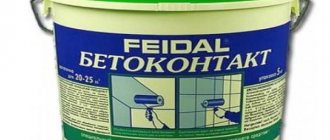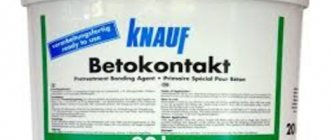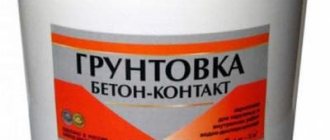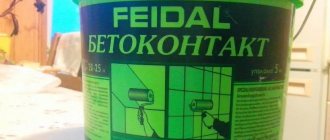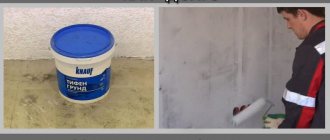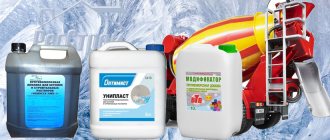In order to prevent the plaster from falling off the ceiling, the wallpaper from peeling off and the tiles to hold firmly in place, a special product has been developed - “Betonokontakt”, another name is “Concrete-contact”. The article describes the features of this type of primer, the rules for selection and application.
High-quality interior decoration is characterized not only by neatness and aesthetics, but also by durability. The panel houses in which the majority of the townspeople live are structures made of reinforced concrete slabs. Therefore, when starting to renovate their apartment, people most often deal with the smooth concrete surfaces of these slabs, be it the ceiling, walls or floors. It is quite difficult to securely attach any finishing materials to them.
Why do you need “Betonokontakt”?
To improve the “adhesion” of the concrete base to plaster, putty, wallpaper, paint, tiles or other materials, a special type of primer called “Concrete Contact” is used. The specificity of this product is due to its composition, which usually includes:
- polymer base;
- quartz sand;
- cement;
- various additives (including biocides).
When applying the Betonokontakt primer, the following happens - on the one hand, the composition firmly “eats” into the base, and on the other, it creates a rough layer on the surface to which any type of finishing materials is securely attached. The use of concrete contact significantly increases the adhesive properties of the walls, their ability to form a strong connection with the next layer of finishing.
The “Concrete Contact” primer is used not only for working with concrete, but also in other cases when the base is too smooth and unreliable to cover with other materials (old paint, tiles, wood, glass or metal). However, manufacturers are not responsible for the effectiveness of such use of a primer, so when choosing, you should carefully read the packaging to ensure that the purpose of the product matches your goals.
Concrete contact is widely used for a variety of finishing works; it is applied:
- before covering with plaster or putty, to prevent crumbling;
- before painting, wallpapering or laying tiles;
- to reduce the formation of dust and dirt.
Purpose
The main purpose for which concrete contact is needed is to create a relief surface for subsequent cladding with finishing materials - plasters, putties, masonry mortars for tiles. It must be used to process any smooth surfaces. In addition, it strengthens the base and extends its service life.
So, concrete contact is used:
- for treating walls and floors before plastering. The ceiling is covered with mortar only if heavy cladding is created (pasting or plastering). Before painting, a primer treatment is sufficient;
- for coating smooth cement plasters before facing;
- for preparing concrete and brick surfaces.
Concrete contact replaces conventional primers for stone of medium and high porosity, stabilizing the surface quality, thereby reducing the consumption of finishing materials. They form a stronger and higher quality base for plaster and screed.
Specifications
The finished primer is a viscous liquid, usually pinkish in color. It has the following characteristics:
- Special adhesive additives in the concrete contact composition allow it to firmly bond even to the most problematic and dusty surfaces.
- Quartz sand increases the adhesion of the product to cement or wood, and also forms a rough layer with high adhesion on the treated surface.
- Biocidal additives prevent materials from being damaged by bacteria or mold.
- Durability of the composition. According to manufacturers, primer applied to various substrates can retain its properties for several decades.
- Waterproof. Can perform the function of waterproofing.
Why do you choose Betonokontakt?
Changing characteristics include soil consumption and the rate of drying. The first indicator depends on the type of primer and the characteristics of the surface on which it is applied. Concrete contact consumption per 1 m2 ranges from 200 to 400 grams. The answer to the question of how long it takes Concrete Contact to dry depends on the temperature and humidity conditions in the room (on average 3-4 hours).
Varieties
Primer for concrete and smooth non-absorbent surfaces is divided into 2 types:
- concrete contact for external work;
- for interior work;
- universal.
The soil for outdoor work is predominantly frost-resistant, able to withstand winter frosts and atmospheric influences (humidity, temperature changes, solar UV rays). Concrete contact for interior work is resistant to moisture and fungi, and forms an ideal surface for interior decoration.
The universal concrete primer is suitable for indoor and outdoor work and meets the requirements for indoor and outdoor use at the same time. This is convenient to purchase during construction, when there is a need for parallel or sequential cladding of rooms and facades.
Rules of application
Using the Betonokontakt primer does not require any special skills and is accessible even to beginners in repairs, however, some nuances must be kept in mind.
Before starting work, you must thoroughly clean the surface. The strength of the connection between the materials will subsequently depend on this. Depending on the condition of the wall, you need to either clean it with a spatula, wash it, or simply wipe it free of dust. Small cracks are not a serious obstacle to work, since the adhesive properties of the composition make it possible to strengthen the top layer of the base.
When working with a cement or concrete base, it would be advisable to treat it with a regular deep penetration primer before applying the actual concrete contact in order to strengthen the outer layer and remove dust. Such preparation will improve the quality of adhesion and reduce mixture consumption.
The temperature regime at which work is carried out is of great importance. Manufacturers indicate the optimal range from 5 to 30 degrees Celsius. At the specified temperatures, the Concrete Contact primer is easy to apply and dries well. At sub-zero temperatures, the consistency changes and it becomes difficult to work; in addition, freezing significantly worsens the quality.
Before application, the primer must be thoroughly mixed in the container, since stratification often occurs during storage (due to components of different densities in its composition).
Concrete contact is applied using a foam roller or a wide brush. The thick consistency allows the primer to adhere well, so it is convenient and easy to apply. Specific colors and good density make it easy to control the uniformity of application. This is very important, since the reliability of the final finish will depend on the quality of processing.
Experts consider it most effective to apply such primer in the form of short strips, alternating vertical and horizontal. Damaged areas should be treated twice.
It is necessary to continue finishing work immediately after the concrete contact layer has dried, because otherwise it will have time to become covered with dust, and this will worsen the adhesive properties of the treated area. For the same reason, only that fragment of the floor, ceiling or wall that can be covered within the specified period should be covered with this type of soil.
If less than two days have passed after the mixture has dried, it is enough to cover the prepared area with a layer of ordinary deep penetration primer, and then continue finishing. If the break in work was longer, the concrete contact treatment will have to be repeated.
What is it used for?
Concrete contact is a type of primer on a sand-cement base with a large number of polymer additives. The main task of this material is to increase adhesion (adhesion of surfaces to each other). In a few minutes you can increase the adhesion of any material to the wall. To do this, you just need to apply concrete contact.
It is very difficult to apply plaster on a completely flat wall - it will peel off and then fall to the floor. After treatment with concrete contact, the wall becomes slightly rough. Any finish will fit easily onto such a base.
Manufacturers
There are so many manufacturers on the building materials market today that it seems that choosing the right concrete contact is an impossible task. However, do not rush to panic.
Firstly: not all the mixture may be suitable. Manufacturers provide detailed information about the properties and purpose of the primer directly on the label. Just be careful here.
Secondly: the price range is quite decent. Focus on your budget and look for the best option. The abundance of products, in such a situation, only helps. If there are already favorites among the brands in terms of the quality of building materials, you can ask the seller if they produce the required concrete contact. This will also help make your search easier.
The table below provides a brief overview of the characteristics of popular brands of concrete contact. He will clarify which one is better.
| Brand and average consumption | Characteristics |
| "Knauf" 350 g/m2 | The popular brand uses quartz filler of various fractions as the main ingredient. It increases the “adhesion” of the mixture to the surface, which creates a qualitative advantage over competitors. |
| "Ceresit" 400 g/m2 | The mixture is pink. In addition to excellent functional qualities, it has proven itself to be the best in facing work. The Ceresit ct-16 soil mixture is an analogue of concrete contact, but its price tag will be higher. |
| "Axton" 300 g/m2 | A dry mixture containing marble chips instead of sand. The composition is diluted with water and mixed independently. The color of the concrete contact is white, universal - used for internal and external types of work. Its peculiarity is the possibility of application to uncleaned substrates. |
| “Prospectors” 200 g/m2 | The product composition is supplemented with latex additives. This helps it dry quickly in less than an hour, which is convenient for “quick” repairs. But it is used only for interior work. |
| "Bolars" 500 g/m2 | Concrete contact is produced with fractions of 2 types - 0.3-0.6 mm and 0.6 mm. But many note the high consumption of the mixture due to the expanded clay filler it contains. Drying time is about 12 hours. However, the material has a special advantage - resistance to frost, as well as very high temperatures (from -50 to +70 degrees). |
| "Osnovit" 300 g/m2 | "Bettokont" is suitable for work indoors and outdoors. The mixture is quite thick and requires some effort to apply, but has the great advantage of short drying time (up to 2 hours). |
| "Unis" 200 g/m2 | Concrete contact is suitable for indoor and outdoor work. The manufacturer allows the mixture to be diluted with water and treated with concrete surfaces before applying tile adhesive or plaster. |
| "Birss" 200 g/m2 | The domestic water-dispersion primer "Birss" is popular due to its low consumption and low price. The material is used for interior work and provides excellent protection against fungus. |
| "Feidal" 300 g/m2 | Premium material. Environmentally friendly composition. It is recommended to use for repair work in ancient buildings where oil paints or drying oil were used for finishing. |
| "Eskaro" 250 g/m2 | A primer that is diluted with water according to the instructions. It has an easy-to-apply texture and does not require constant stirring. However, the mixture has a strong odor, so it is recommended to work in a ventilated area and use a mask. |
Concrete contact has been selected, but it is important not to come across a fake when purchasing. In order not to waste time and effort working with counterfeits, it is better to first check the primer in use. Visually, no lumps or clots should be visible in the mixture. If there are any, return the concrete contact to the store. Next, you can do a little testing on any surface with your own hands: apply the required layer and wait until it dries completely. Did you manage to break it off? If not, great, you’ve purchased high-quality material and you can safely get to work.
Best ?
During the finishing process, it is important to understand that it is strictly not recommended to skimp on primer during application. Any professional will tell you that the thickness and uniformity of the layer play a major role in adhesion to the material. If applied incorrectly and if you save too much, there is a big risk of ruining everything: the tiles will soon fall off and the wallpaper will peel off. It is allowed to dilute the concrete contact with water only if the work will be carried out manually. Manufacturers always mention this possibility in the instructions.
Advantages and disadvantages
The almost “magical” material has more of the former, but there are also some disadvantages.
First you need to give a list of advantages. These include:
- Versatility. The mixture does not require tedious and thorough surface preparation before application. The only conditions are their smoothness and inability to absorb moisture excessively.
- High strength. The dried layer of concrete contact is not afraid of any construction work. Cracks will not appear even when drilling.
- The ability to make porous surfaces maximally protected from moisture. This applies to gypsum, wood, brick and foam and aerated concrete.
- Absolute immunity of the dried material to significant temperature changes. However, it can be applied if it is above +5° outside.
- Environmentally friendly. The adhesive composition does not contain any toxic substances that would make the primer unsuitable for interior work.
- High drying speed. A few hours after surface treatment, you can begin further finishing work.
- Durability of the layer. Manufacturers claim that the primer does not lose quality for 80 years.
- Complete absence of fear of ultraviolet radiation and fire safety.
- Vapor permeability due to polymers that can “breathe”.
Recommendations
Most often, the types of concrete contact differ in the size of the grains of sand in the composition. The choice of the desired primer is made depending on the working surface. But otherwise the technical characteristics of the material are the same. The first thing you need to pay attention to when purchasing is the tightness of the container. This will guarantee the novelty and quality of the mixture. Obtaining the maximum effect is possible if you use concrete contact immediately after opening. If work with it is planned after some time, then opening the container is prohibited, and it must be stored in accordance with the manufacturer’s conditions. This way the mixture will not lose its properties and will not dry out. However, it is better to use the primer within 1 year from the date of production.
When starting to work with concrete contact, follow the recommendations:
- You cannot plaster with a cement mixture over concrete contact - only over the concrete itself. The strength of the material does not meet the standard indicators for covering with cement mortar.
- It is better to carry out work in a room with air humidity of no more than 70%.
- Pre-treatment of the base with a deep penetration primer will reduce the consumption of concrete contact and increase adhesion. However, several coats of primer may be required, depending on the substrate. This will additionally clean the surface and strengthen it (material consumption per square meter is about 300-400 g).
- Finishing can be done without special training and independently. The material does not require special knowledge or professional skills, however, if the work needs to be done quickly and efficiently, it is better to enlist support or turn to specialists.
Do you prime yourself or hire specialists?
How to prepare the mixture?
Often there is no need to prepare this mixture - manufacturers are ready to sell a completely ready-made solution. When purchasing such a concrete contact, it is enough to stir all the contents until smooth. It must be remembered that it can only be stored at positive temperatures.
Nowadays, few people prepare such mixtures with their own hands, because you need to know exactly the proportions, buy all the necessary materials, and also dilute them correctly with water. Then you need to wait and watch how the solution thickens. This is extremely energy-consuming, so everyone buys ready-made concrete contacts. You just need to read the instructions for use and work with this composition correctly.
What not to do
If you are working with a primer for the first time, then first be sure to familiarize yourself with all the rules and recommendations. Next, it is very important to find out what actions with soil-concrete contact are strictly prohibited. Examples from life and the opinions of professionals prove that this list is not small. Studying it will help you avoid everyday problems and be confident in a quality result.
Thus, when working with concrete contact, the following is prohibited:
- apply to a dirty, uncleaned surface (some manufacturers allow application directly to paint or tiles);
- use over bitumen mastic;
- dilute the composition with water in greater quantities than indicated by the manufacturer in the instructions;
- apply the mixture to a wet, damp surface;
- use the composition without first stirring;
- apply to the base at negative air temperatures;
- use expired composition;
- apply the primer without waiting for complete drying;
- Continue working if dust gets on the layer. It sticks very well, but then falls off along with the plaster.
Application concretecontact | Where not to use and where it is recommended to use concrete contact
Betokontakt Axton is washed off with water
Good day, dear masters. I bought a 6 kg can of Betokontakt Axton in Leroy in the summer of 2022. In December of the same year, I used it to treat a 3 sq.m concrete wall in the bathroom. I noticed the following: after drying, the composition adheres well to the wall, however, as soon as you wet it and rub it with your finger, it is washed off along with the sand. For the sake of testing, I threw a piece of plaster (20x20x7cm) with a rotband onto the primed surface - after hardening it holds well. You can’t beat it off with a hammer. The betocontact of this company itself belongs to the budget price category.
1) Do you think it is possible to continue plastering the wall using water-soluble concrete contact? Will a 2 cm layer of rotband slide off? 2) Don't take risks. Sand it off and apply more expensive betokontakt? 3) Don't take risks. Sand it off and spray (or a thin layer) with tile adhesive? 4) Try fixing it with a primer like Knauf Tiefengrund?
Regards, Alexey.
Alexey Elme159 wrote: I noticed the following: after drying, the composition sticks well to the wall, however, as soon as you wet it and rub it with your finger, it is washed off along with the sand.
How long did it take for the composition you tested to dry?
Alexey Elme159 wrote: 1) Do you think it is possible to continue plastering the wall using water-soluble concrete contact? Will a 2 cm layer of rotband slide off?
Alexey Elme159 wrote: Sand it off and apply more expensive betocontact?
Why sand if, as you claim, it is water soluble? - can be dissolved and washed off with water then
How long did it take for the composition you tested to dry?
Gray, it dried out for two days.
Gray wrote: Why sand if, as you claim, it is water soluble? - can be dissolved and washed off with water then
I think I can remove it faster with a grinder. You can’t completely remove a wet one from the wall. Still, something will remain.
Alexey Elme159, Different compositions based on acrylic copolymers take a very long time to polymerize. Before polymerization is completed, they can be washed off with water. Moreover, in many cases, polymerization interferes with the performance of functions.
Can the primer be diluted with a solvent?
There is no general solvent for all types of primer, since primers have different compositions, so you need to look at the recommendations that are indicated on the packaging (can) with the primer. Typically, solvent, white spirit, various solvents (registered) are used for this purpose; sometimes it is possible to use acetone.
Interesting materials:
How much alcohol can be exported from Russia? How many seas wash the territory of Russia? How many pensioners are there in Russia? How many subjects does the administrative-territorial division of the Russian Federation include? What place does Russia occupy in the world in terms of natural resource reserves? Where does Russia rank in terms of oil reserves? Where does Russia rank in terms of living standards in the world? What place does Russia occupy in the world in terms of coal reserves? What place does Russia occupy in the world in terms of proven natural gas reserves? Where does Russia rank in terms of GDP?
Is it possible to save money?
No. This is the expert opinion of the manufacturers. They argue that a strong (sometimes even small) dilution of the composition will significantly reduce the adhesive properties of the concrete contact, which means that there is a possibility that it will not be able to stay on the surface. In addition, too liquid a consistency will not ensure the quality of the coating: water will be absorbed or evaporate instantly, and this speed will prevent reliable adhesion.
A possible result of such actions is the formation of cracks. In this case, the entire process will have to be repeated, which means excess material consumption is inevitable. A mixture that is too watery threatens with an invisible drawback that will come back to haunt you in the future: the waterproofing characteristics of the base will be insufficient. The first potential consequence is mold, but there may be others. Since concrete contact does not have any unaffordable, astronomical price, it is simply unreasonable to encounter possible problems due to small benefits.
Features of the composition
Today GB is manufactured by many companies. These products are not very different from each other. Each primer is based on acrylic, which provides good adhesion to surfaces.
The acrylic base is diluted with cement, sand and other additional fillers. Thanks to these components, the positive qualities of the primer are ensured.
GS is suitable for processing porous and smooth surfaces. It can be processed:
- concrete;
- metal;
- ceramics;
- tree;
- plastic;
- drywall.
Once these materials are coated with GB, they are ready for plastering. Finishes you can use:
- cement;
- lime;
- plaster;
- alabaster.
After priming, even on moisture-resistant surfaces, this plaster will adhere perfectly.
